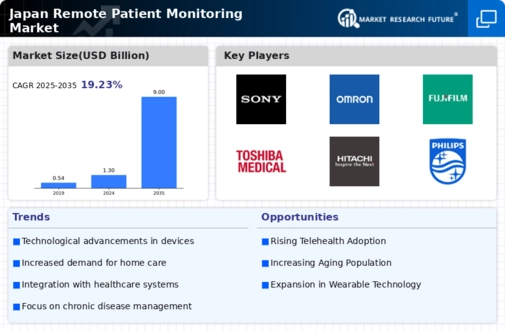Aging Population
The aging population in Japan is a critical driver for the remote patient-monitoring market. As the demographic shifts towards an older age group, the demand for healthcare services increases significantly. In 2025, it is estimated that over 30% of the population will be aged 65 and above. This demographic is more susceptible to chronic diseases, necessitating continuous monitoring and management. Remote patient-monitoring technologies provide a solution by enabling healthcare providers to track patients' health metrics in real-time, thus improving patient outcomes and reducing hospital visits. The remote patient-monitoring market is likely to see substantial growth as healthcare systems adapt to meet the needs of this aging population. It could potentially reach a market value of $2 billion by 2027.
Government Initiatives
Government initiatives aimed at enhancing healthcare delivery are significantly influencing the remote patient-monitoring market. The Japanese government has been actively promoting digital health solutions to improve access to healthcare services, particularly in rural areas. Initiatives such as subsidies for telehealth technologies and support for healthcare providers adopting remote monitoring systems are expected to drive market growth. By 2026, it is anticipated that government funding for digital health initiatives will exceed $500 million, further encouraging the adoption of remote patient-monitoring solutions. These efforts not only aim to improve patient care but also to streamline healthcare operations, making the remote patient-monitoring market a focal point for future healthcare strategies.
Healthcare Cost Reduction
The rising costs of healthcare in Japan are driving the adoption of remote patient-monitoring solutions. By enabling patients to manage their health from home, these technologies can significantly reduce the need for hospital admissions and emergency visits. Studies indicate that remote monitoring can lower healthcare costs by up to 20% by minimizing unnecessary hospitalizations. This cost-effectiveness appeals to both healthcare providers and patients, making remote patient-monitoring an attractive option. As the healthcare system seeks to balance quality care with cost efficiency, the remote patient-monitoring market is likely to expand, with an increasing number of healthcare facilities implementing these solutions to manage expenses.
Technological Integration
The integration of advanced technologies into healthcare systems is propelling the remote patient-monitoring market forward. Innovations such as artificial intelligence, machine learning, and IoT devices are enhancing the capabilities of remote monitoring solutions. These technologies allow for more accurate data collection and analysis, enabling healthcare providers to make informed decisions. In Japan, the government has been promoting the use of digital health technologies, which is expected to increase the adoption of remote monitoring solutions. As a result, The remote patient-monitoring market will be projected to grow at a CAGR of 15% over the next five years, driven by the need for efficient healthcare delivery and improved patient management.
Chronic Disease Management
The prevalence of chronic diseases in Japan is a major driver for the remote patient-monitoring market. Conditions such as diabetes, hypertension, and heart disease require ongoing management and monitoring. Remote patient-monitoring technologies facilitate this by allowing patients to track their health metrics and share data with healthcare providers. This continuous monitoring can lead to better disease management and improved patient outcomes. With approximately 30% of the Japanese population living with at least one chronic condition, the demand for effective monitoring solutions is expected to rise. Consequently, the remote patient-monitoring market is poised for growth as healthcare providers seek innovative ways to manage chronic diseases.




















Leave a Comment